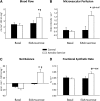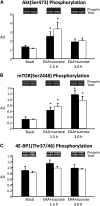A moderate acute increase in physical activity enhances nutritive flow and the muscle protein anabolic response to mixed nutrient intake in older adults
- PMID: 22572647
- PMCID: PMC3349455
- DOI: 10.3945/ajcn.111.020800
A moderate acute increase in physical activity enhances nutritive flow and the muscle protein anabolic response to mixed nutrient intake in older adults
Abstract
Background: Nutrient stimulation of muscle protein anabolism is blunted with aging and may contribute to the development and progression of sarcopenia in older adults. This is likely due to insulin resistance of protein metabolism and/or endothelial dysfunction with a reduction in nutritive flow, both of which can be improved by aerobic exercise.
Objective: Our objective was to determine whether increasing physical activity can enhance the muscle protein anabolic effect of essential amino acid (EAA) + sucrose intake in older subjects by improving nutritive flow and/or insulin signaling.
Design: Using a randomized crossover design, we measured in older subjects [n = 6, 70 ± 3 y of age, BMI (in kg/m2) of 25 ± 1] the acute effects of increasing physical activity with aerobic exercise, as compared with normal sedentary lifestyle, on the response of blood flow, microvascular perfusion, insulin signaling, and muscle protein kinetics to EAA+sucrose intake.
Results: No differences between treatment groups were found in the basal state. The change from the basal state in blood flow, muscle perfusion, phenylalanine delivery, net balance, and muscle protein synthesis during the consumption of EAA+sucrose was significantly higher after the exercise than after the control treatment (P < 0.05). Insulin signaling increased during EAA+sucrose ingestion in both groups (P < 0.05).
Conclusions: Our data indicate that a prior bout of aerobic exercise increases the anabolic effect of nutrient intake in older adults. This effect appears to be mediated by an exercise-induced improvement in nutrient-stimulated vasodilation and nutrient delivery to muscle rather than to improved insulin signaling. This trial was registered at clinicaltrials.gov as NCT00690534.
Figures




Similar articles
-
The impact of delivery profile of essential amino acids upon skeletal muscle protein synthesis in older men: clinical efficacy of pulse vs. bolus supply.Am J Physiol Endocrinol Metab. 2015 Sep 1;309(5):E450-7. doi: 10.1152/ajpendo.00112.2015. Epub 2015 Jul 7. Am J Physiol Endocrinol Metab. 2015. PMID: 26152764
-
Essential amino acid-enriched whey enhances post-exercise whole-body protein balance during energy deficit more than iso-nitrogenous whey or a mixed-macronutrient meal: a randomized, crossover study.J Int Soc Sports Nutr. 2021 Jan 7;18(1):4. doi: 10.1186/s12970-020-00401-5. J Int Soc Sports Nutr. 2021. PMID: 33413462 Free PMC article. Clinical Trial.
-
Muscle Protein Anabolic Resistance to Essential Amino Acids Does Not Occur in Healthy Older Adults Before or After Resistance Exercise Training.J Nutr. 2018 Jun 1;148(6):900-909. doi: 10.1093/jn/nxy064. J Nutr. 2018. PMID: 29796648 Free PMC article.
-
Dietary proteins and amino acids in the control of the muscle mass during immobilization and aging: role of the MPS response.Amino Acids. 2017 May;49(5):811-820. doi: 10.1007/s00726-017-2390-9. Epub 2017 Feb 7. Amino Acids. 2017. PMID: 28175999 Review.
-
Role of Exercise and Nutrition in the Prevention of Sarcopenia.J Nutr Sci Vitaminol (Tokyo). 2015;61 Suppl:S125-7. doi: 10.3177/jnsv.61.S125. J Nutr Sci Vitaminol (Tokyo). 2015. PMID: 26598823 Review.
Cited by
-
Defining meal requirements for protein to optimize metabolic roles of amino acids.Am J Clin Nutr. 2015 Jun;101(6):1330S-1338S. doi: 10.3945/ajcn.114.084053. Epub 2015 Apr 29. Am J Clin Nutr. 2015. PMID: 25926513 Free PMC article.
-
Regulation of muscle protein synthesis and the effects of catabolic states.Int J Biochem Cell Biol. 2013 Oct;45(10):2147-57. doi: 10.1016/j.biocel.2013.05.039. Epub 2013 Jun 12. Int J Biochem Cell Biol. 2013. PMID: 23769967 Free PMC article. Review.
-
Lifestyle and sarcopenia-etiology, prevention, and treatment.Rambam Maimonides Med J. 2012 Oct 31;3(4):e0024. doi: 10.5041/RMMJ.10091. Print 2012 Oct. Rambam Maimonides Med J. 2012. PMID: 23908848 Free PMC article.
-
Role of Ingested Amino Acids and Protein in the Promotion of Resistance Exercise-Induced Muscle Protein Anabolism.J Nutr. 2016 Feb;146(2):155-83. doi: 10.3945/jn.114.203208. Epub 2016 Jan 13. J Nutr. 2016. PMID: 26764320 Free PMC article. Review.
-
Protein Considerations for Optimising Skeletal Muscle Mass in Healthy Young and Older Adults.Nutrients. 2016 Mar 23;8(4):181. doi: 10.3390/nu8040181. Nutrients. 2016. PMID: 27023595 Free PMC article. Review.
References
-
- Fried LP, Hadley EC, Walston JD, Newman AB, Guralnik JM, Studenski S, Harris TB, Ershler WB, Ferrucci L. From bedside to bench: research agenda for frailty. Sci Aging Knowledge Environ 2005;2005:pe24 - PubMed
-
- Janssen I, Heymsfield SB, Ross R. Low relative skeletal muscle mass (sarcopenia) in older persons is associated with functional impairment and physical disability. J Am Geriatr Soc 2002;50:889–96 - PubMed
-
- Janssen I, Baumgartner RN, Ross R, Rosenberg IH, Roubenoff R. Skeletal muscle cutpoints associated with elevated physical disability risk in older men and women. Am J Epidemiol 2004;159:413–21 - PubMed
Publication types
MeSH terms
Substances
Associated data
Grants and funding
LinkOut - more resources
Full Text Sources
Other Literature Sources
Medical

